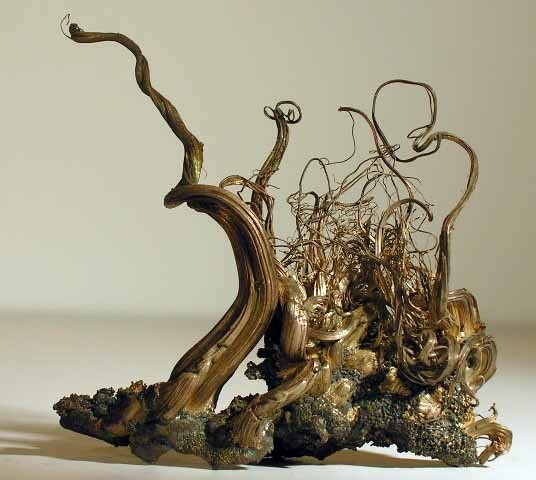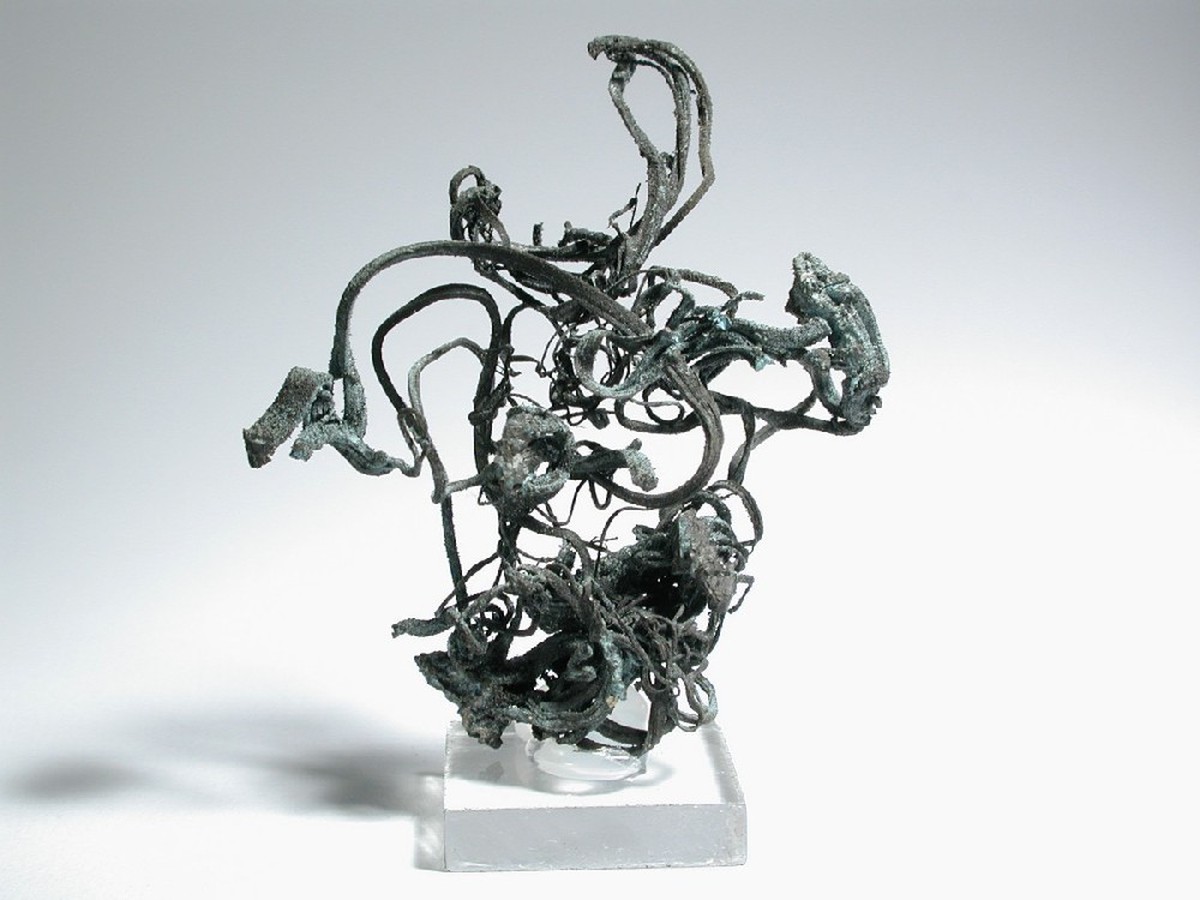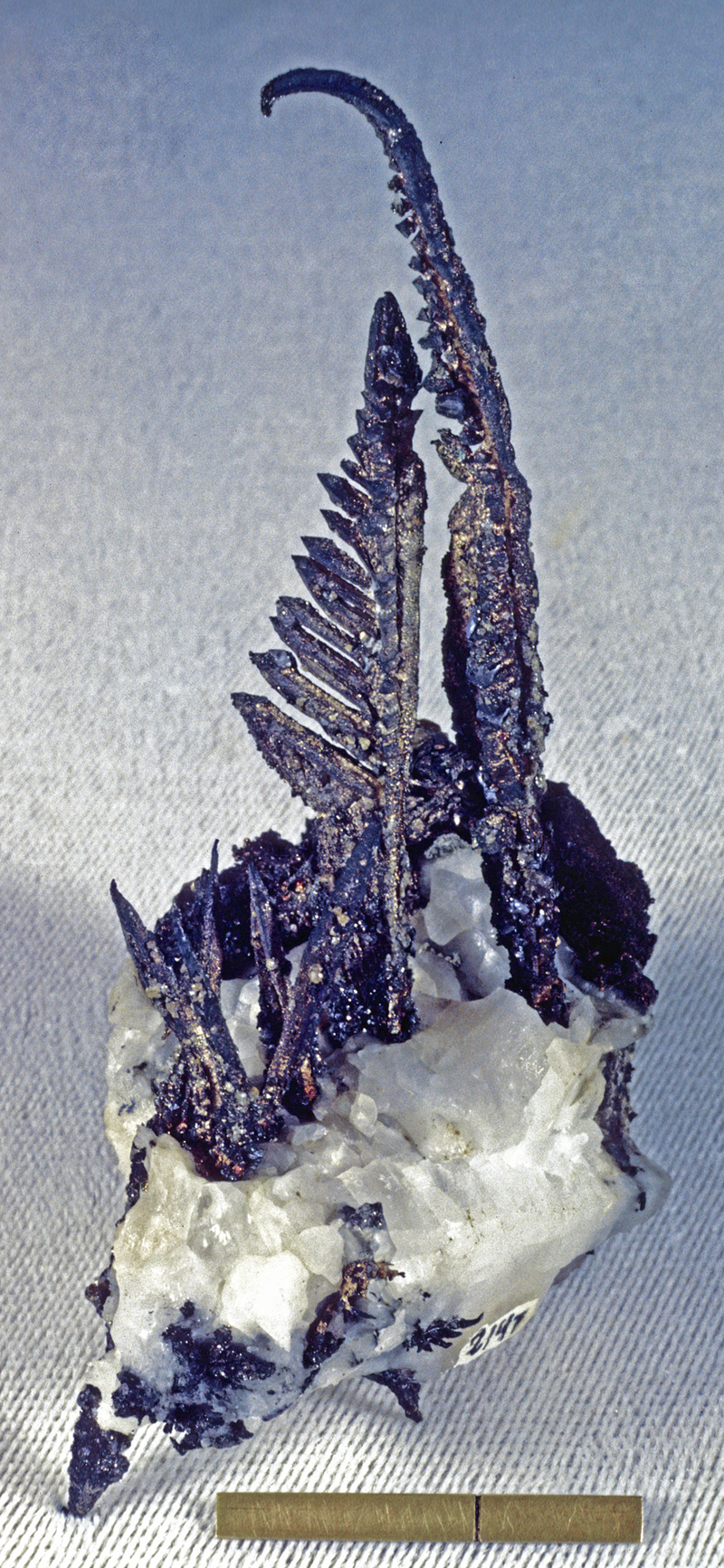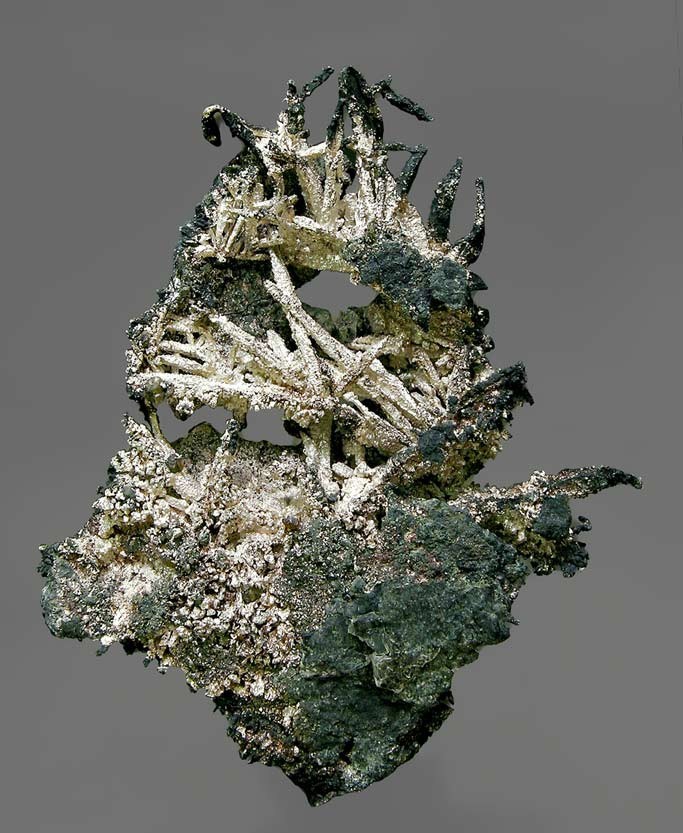Silver specimens are readily available (although good ones can be expensive). The most common habits are wires or as reticulated masses of twinned crystals (herringbone). It is relatively simple to artificially grow silver wires. The first major production of silver was obtained by the Chaldeans via cuppellation in ~ 2500BC. Historically Athens used the silver found in the Laurium area to pay for it becoming a naval power circa 483BC and the mines were a major source of silver until the Romans began exploiting Spanish mines. In the Middle ages, the German and Central European deposits were exploited. Spanish colonization of the Americas resulted in production from the Andes Mountains (Bolivia and Peru) and Mexico. The gold rushes in the American west often led to the discovery of significant silver deposits such as the Comstock Lode, Nevada and Leadville, Colorado.
Silver is found in a number of hydrothermal deposits, but most of the better reticulated masses come from Ag-Ni-Co-Bi-U-As veins. The wires usually form in supergene enrichment zones. Also, silver has been found associated with copper in red bed sedimentary deposits. Silver is also found as various sulfide, sulfosalt and halide minerals. Some of the native silver specimens have been cut and polished for jewelry making. Native silver specimens can occur in large masses. Duke Albrecht and his entourage in 1477 were in the St. Georg mine in Schneeburg and ate a meal on a 4x2x1 meter mass of native silver (the "Silbertisch" - silver table). Possibly the largest mass of silver was found in a surface outcropping on the Lawson mine property in Cobalt, Ontario named the "Silver Sidewalk". The shoot measured 100 m long, 60m deep and up to 0.5m wide and consisted of native silver and cobalt arsenides. Silver specimens were able to evade the smelter early in mine lives (the owners tended to call it "highgrading"), but over time as miners ran into a need for money, many specimens ended up being melted in assay offices. The extraordinary quality and size of specimens from the old classic locality of Kongsberg, Norway prevented the destruction of numerous specimens, but even many of these ended up in the smelters.
Australia
New South WalesCobar, Elura Mine (Endeavor Mine)This locality is known for extremely long spinel law twinned crystals which form into wires.
Czech Republic
Bohemia (Böhmen; Boehmen), Central Bohemia Region, PříbramGermany
Baden-Württemberg, Black Forest, Schenkenzell, WittichenSaxony, Erzgebirge, Freiberg District, Freiberg
This mining district was discovered discovered in late 12th century. Some collectors think that many of these specimens that have recently come to the market place are man made.
Saxony, Erzgebirge, Freiberg District, Brand-Erbisdorf, Himmelsfürst Mine
Saxony, Erzgebirge, Schwarzenberg District, Pöhla, Pöhla-Tellerhäuser Mine
Kazakhstan
Karagandy Province (Qaragandy Oblysy; Karaganda Oblast'), Dzhezkazgan (Zhezqazghan), Dzhezkazgan Mine (Zhezqazghan Mine)Mexico
Chihuahua, Mun. de Batopilas, Andres del Rio District, BatopilasChihuahua, Mun. de Batopilas, Andres del Rio District, Batopilas, New Nevada Mine
Norway
Buskerud, Kongsberg, Kongsberg Silver Mining DistrictKongsberg is the most famous locality for silver specimens. Wires of silver up to about a meter long are known, crystals are known to about 5 cm. There is a 17kg, mass of wire silver in the museum at Kongsberg. In addition, some specimens are associated with well formed disk like calcite crystals with wire silver growing through them and others are associated with fluorite crystals.
United Kingdom
Scotland, Central Region (Clackmannanshire), Alva, Silver Glen, Alva Silver MineThe first two specimens shown here were collected by Stephen Moreton. His comments abut them are interesting. "My two best ever finds, from my student days in the 1980s. I call them the "Crown Jewels" of my collection and they were the result of years of methodical excavation of the waste heap of Scotland's richest silver mine (indeed the richest bonanza of native silver ever found in the British Isles)"
USA
Michigan, Keweenaw PeninsulaAlthough not as well known as the copper specimens produced by the mines of the Keweenaw Pensinsula, much silver was mined and saved by the miners. To many of the early miners it was called white copper. The miners and mine captains considered it as a sort of unapproved bonus to their regular saleries. The best known specimens are the "half-breeds", specimens consisting of separate areas of copper and silver. Some of the best of these show crystals of silver with copper. In these specimens the copper is usually less well crystallized than the silver. Many half-breed "nuggets" have been found. Many were produced in the stamp mills of the refineries or by glacial action. Recorded silver production is 16 million ounces, but probably twice that amount was mined. The best silver specimens were found in the Kearsarge and Pewabic lodes as well as the fissure mines. Wire silver is rare, most specimens are herringbone aggregates or "spikes" (up to 10cm). Most are octahedral or dodecahedral crystals although rare cubes (to 5mm) have been found. Many specimens are simply labeled Silver, Keweenaw Peninsula, Michigan because most specimens were removed from the mines by the miners without company permission (strictly speaking they were stolen) and placing a mine name on them might cause "heat" from the management. The copper producing areas of the Keweenaw Peninsula are mostly encompassed by Keweenaw and Houghton and Ontonagon Counties in the state of Michigan, USA.
Michigan, Houghton Co., Kearsarge, Kearsarge Mine
Michigan, Keweenaw Co.
Michigan, Ontonagon Co.
Michigan, Ontonagon Co., White Pine, White Pine Mine
Arborescent and herringbone aggregates in calcite veins from the southwest orebody.
Article has been viewed at least 3340 times.






























































